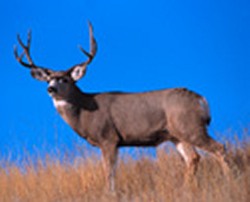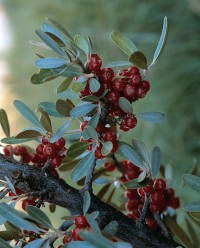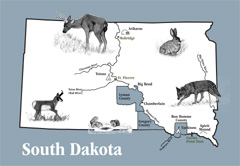 |
|
Lesson 3 The explorers met the Tetons and the Arikaras on the high plains. The high plains lie in the middle of the Great Plains. The Great Plains are one of the largest grasslands in the world. In this environment, Lewis and Clark saw new plants and animals. The trip between the Niobrara River and the Bad River was the most exciting. Here Lewis and Clark found many plants and animals that scientists had never seen before. It was the most important zoological part of the whole trip. Near Gregory County, South Dakota, Lewis and Clark first saw prairie dogs (Cynomys ludovicianus). They called them "barking squirrels." Lewis and Clark were right. Prairie dogs are in the squirrel family. These animals dig tunnels for homes and live together in big groups. The size of their "towns" amazed the corps. The first town the explorers saw covered four acres. Prairie dogs still live in South Dakota today. Their towns are not as big as they once were.
|
|
|
Lewis and Clark called pronghorns "goats" when they first saw them. People today often call them "antelopes." That name is not right, either. The pronghorn (Antilocapra americana) belongs to a different animal family from the goat or antelope. Lewis and Clark killed the first pronghorn in Lyman County. Lewis thought it ran faster than a race horse. He was right. The pronghorn is one of the fastest animals in the world. Only the cheetah is faster. Near the same place, the corps killed its first white-tailed jack rabbit (Lepus townsendi). Jack rabbits are not really rabbits. They are hares. Hares do not burrow into the ground, and their babies are born with fur. Lewis guessed that jack rabbits could jump up to twenty feet. He was right. Jack rabbits adjust well to South Dakota winter. Their fur turns white to match snow. |

|
The explorers shot a new type of deer near Chamberlain. They named it a mule deer. To them, these animals looked like other deer in the way that mules look like horses. Mule deer (Odocoileus hemionus) are bigger and have longer ears than white-tailed deer. The next day, the corps caught the first coyote (Canis latrans). Lewis and Clark had been trying for five weeks to catch one to send back to scientists in the East. Today, the coyote is South Dakota’s state animal. The explorers also made important botanical discoveries. They wrote in their journals about the plants they found. In August, they wrote about the prairie turnip (Psoralea esculenta). The Lakotas called it tinpsila. This plant has a starchy root. It can be eaten like a potato. It can also be pounded into a flour and made into bread.
|
|
In Bon Homme County, they first saw buffaloberry (Shepherdia argentea). Buffaloberry shrubs have bright green leaves and red berries. American Indians used them for food. They made things like pemmican, which they still do. Lewis and Clark made small pies with the fruit. On September 21, the corps reached the Big Bend in the Missouri River near Fort Thompson. The corps measured the land across to the other side. It was about a mile. By water, it was thirty miles. Near the Big Bend, they found six new plants. The corps found silver sagebrush (Artemisia cana) on October 1. They were near the mouth of the Cheyenne River. Silver sagebrush grows in bunches. It provides habitat for many animals. Wildlife also use it for winter food when other plants are covered with snow.
|

|
| Vocabulary | |
| botanical (adj.), dealing with plants
environment (n.), the natural land and weather conditions needed by animals or plants to live and grow Great Plains (n.), a semi-dry region east of the Rocky Mountains in the United States and Canada |
habitat (n.), a place to live. pemmican (n.), dried meat mixed and pressed with fat and often dried berrieszoological (adj.), dealing with animals |

